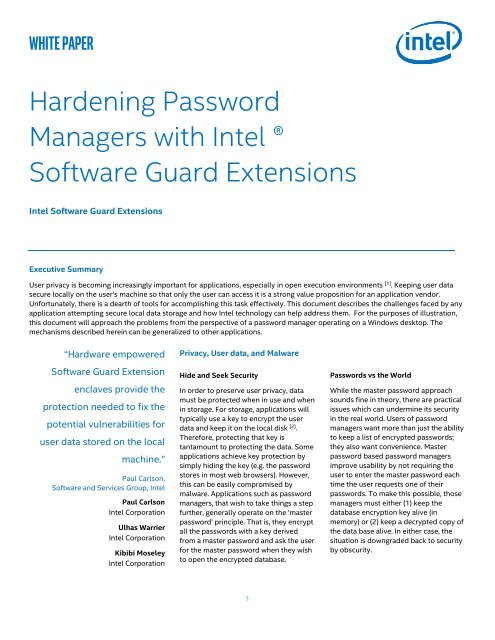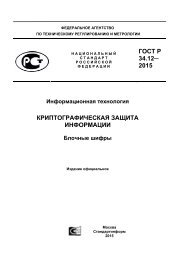Hardening Password Managers with Intel ® Software Guard Extensions
HardeningPasswordManagerswithSGX
HardeningPasswordManagerswithSGX
Create successful ePaper yourself
Turn your PDF publications into a flip-book with our unique Google optimized e-Paper software.
White paper<br />
<strong>Hardening</strong> <strong>Password</strong><br />
<strong>Managers</strong> <strong>with</strong> <strong>Intel</strong> <strong>®</strong><br />
<strong>Software</strong> <strong>Guard</strong> <strong>Extensions</strong><br />
<strong>Intel</strong> <strong>Software</strong> <strong>Guard</strong> <strong>Extensions</strong><br />
Executive Summary<br />
User privacy is becoming increasingly important for applications, especially in open execution environments [1] . Keeping user data<br />
secure locally on the user’s machine so that only the user can access it is a strong value proposition for an application vendor.<br />
Unfortunately, there is a dearth of tools for accomplishing this task effectively. This document describes the challenges faced by any<br />
application attempting secure local data storage and how <strong>Intel</strong> technology can help address them. For the purposes of illustration,<br />
this document will approach the problems from the perspective of a password manager operating on a Windows desktop. The<br />
mechanisms described herein can be generalized to other applications.<br />
“Hardware empowered<br />
<strong>Software</strong> <strong>Guard</strong> Extension<br />
enclaves provide the<br />
protection needed to fix the<br />
potential vulnerabilities for<br />
user data stored on the local<br />
machine.”<br />
Paul Carlson,<br />
<strong>Software</strong> and Services Group, <strong>Intel</strong><br />
Paul Carlson<br />
<strong>Intel</strong> Corporation<br />
Ulhas Warrier<br />
<strong>Intel</strong> Corporation<br />
Kibibi Moseley<br />
<strong>Intel</strong> Corporation<br />
Privacy, User data, and Malware<br />
Hide and Seek Security<br />
In order to preserve user privacy, data<br />
must be protected when in use and when<br />
in storage. For storage, applications will<br />
typically use a key to encrypt the user<br />
data and keep it on the local disk [2] .<br />
Therefore, protecting that key is<br />
tantamount to protecting the data. Some<br />
applications achieve key protection by<br />
simply hiding the key (e.g. the password<br />
stores in most web browsers). However,<br />
this can be easily compromised by<br />
malware. Applications such as password<br />
managers, that wish to take things a step<br />
further, generally operate on the ‘master<br />
password’ principle. That is, they encrypt<br />
all the passwords <strong>with</strong> a key derived<br />
from a master password and ask the user<br />
for the master password when they wish<br />
to open the encrypted database.<br />
<strong>Password</strong>s vs the World<br />
While the master password approach<br />
sounds fine in theory, there are practical<br />
issues which can undermine its security<br />
in the real world. Users of password<br />
managers want more than just the ability<br />
to keep a list of encrypted passwords;<br />
they also want convenience. Master<br />
password based password managers<br />
improve usability by not requiring the<br />
user to enter the master password each<br />
time the user requests one of their<br />
passwords. To make this possible, those<br />
managers must either (1) keep the<br />
database encryption key alive (in<br />
memory) or (2) keep a decrypted copy of<br />
the data base alive. In either case, the<br />
situation is downgraded back to security<br />
by obscurity.<br />
1
Memory is an Open Book<br />
Unfortunately, this is not the only way the data or database key<br />
can be stolen. No matter what method is used to hide the key, it<br />
must be unmasked in order to be used - leaving both the key<br />
and the data being decrypted vulnerable to theft. In an open<br />
execution environment, malicious applications can force a<br />
password manager to ‘break’ at the exact point the data is<br />
exposed by attaching a debugger. Finding the exact point to<br />
‘break’, may be difficult but hackers have unlimited access to<br />
their local copy of the password manager application. Thus,<br />
there exist multiple attack surfaces for malware to attempt to<br />
obtain a user’s data from a local application.<br />
Biometric Authentication<br />
Although the master password approach is common today,<br />
biometrics are a promising addition for user authentication in<br />
the future. Unlike passwords, biometrics cannot be lost,<br />
forgotten, poorly “chosen”, or easily brute-forced. However,<br />
there is an important aspect to consider about the use of<br />
biometrics for password management. With master password,<br />
the encryption key could be removed from the system when a<br />
user session is not open. With biometrics, that key needs to<br />
exist somewhere at all times so that the database can be<br />
decrypted when a biometric provider authenticates the user.<br />
The reason for this is that a biometric match cannot be used to<br />
deterministically create a secret such as an encryption key.<br />
Without this capability, the encryption key must pre-exist on the<br />
system in order for local secure data storage to work. Thus, use<br />
of biometrics requires a solution which can successfully protect<br />
the encryption key (and possibly the biometric match itself).<br />
Requirements for a Solution<br />
There is an important assumption about open execution<br />
environments in the above reasoning. Namely, that there is no<br />
truly effective means of protecting the password manager’s bits<br />
and bytes from malware. Although performing some attacks<br />
may require elevated privileges, phishing software or users that<br />
are unaware of the risks are likely to grant malware the required<br />
elevated privileges via a permission request dialogue. The<br />
security must be stronger than a simple privilege elevation<br />
dialog <strong>with</strong> unclear consequences from a user’s perspective.<br />
What would a better solution require? Application authors need<br />
to be able to specify what parts of their codebase need to be<br />
protected and how those protected sections communicate <strong>with</strong><br />
the rest of the code base. Next, those specifications need to be<br />
enforced by a trusted entity. Finally, the data on disk<br />
representing the protected sections and interfaces needs to be<br />
protected against alteration. All of these security capabilities are<br />
provided by <strong>Intel</strong>’s <strong>Software</strong> <strong>Guard</strong> <strong>Extensions</strong>.<br />
<strong>Intel</strong><strong>®</strong> <strong>Software</strong> <strong>Guard</strong> <strong>Extensions</strong><br />
<strong>Intel</strong><strong>®</strong> <strong>Software</strong> <strong>Guard</strong> <strong>Extensions</strong> (SGX) is <strong>Intel</strong>’s Trusted<br />
Execution Engine. SGX consists of a set of CPU instructions and<br />
platform enhancements that enable applications to create<br />
private trusted environments called enclaves. Within these<br />
enclaves, code and associated data can be protected from<br />
compromise due to attacks from privileged software and many<br />
hardware based attacks. When the code is executed from <strong>with</strong>in<br />
an enclave, that code and data are better protected from<br />
disclosure or modification.<br />
How can <strong>Intel</strong> SGX be used to improve application security? An<br />
application that wants to use SGX to improve its security needs<br />
to be re-factored into trusted and untrusted components. Those<br />
trusted parts of an application can then be run inside one or<br />
more SGX enclaves. Because all memory associated <strong>with</strong> an<br />
enclave is encrypted at the hardware level, code executing<br />
<strong>with</strong>in an enclave is opaque to other software, regardless of<br />
privilege level. Likewise, data associated <strong>with</strong> code executing<br />
<strong>with</strong>in an enclave is also opaque to other software (including the<br />
“untrusted” part(s) of the same application that set up the<br />
enclave(s)) regardless of whether it is sealed on disk or kept in<br />
trusted memory. Thus, all secrets protected by an enclave are<br />
sealed and protected from tampering or theft from outside the<br />
enclave both during execution and at rest.<br />
<strong>Password</strong> Management Protection <strong>with</strong> SGX<br />
Hardware empowered SGX enclaves provide the protection<br />
needed to fix the potential vulnerabilities for user data stored<br />
on the local machine. First, SGX hardware sealing allows secrets<br />
or keys to be encrypted such that only the SGX enclave which<br />
sealed it can open it again. This allows for safe persistence of<br />
encryption keys or other data between sessions. Second, SGX<br />
enclaves provide a protected memory space to safeguard a<br />
cryptographic key (whether pre-existing or derived from a<br />
master password). By sending the master password (or other<br />
key) down into an enclave and keeping it there, the key can both<br />
be kept alive for user convenience and protected against theft<br />
by a means much stronger than obfuscation [4] . Finally, side<br />
channel attacks and memory scanning techniques are thwarted<br />
since the memory is protected by hardware encryption.<br />
Case in Point<br />
True Key, <strong>Intel</strong> Security’s no password application launched in<br />
2015, leverages <strong>Intel</strong> <strong>Software</strong> <strong>Guard</strong> <strong>Extensions</strong> (SGX) to better<br />
protect against sophisticated attacks on its data. This<br />
technology and methodology can be used by other ISVs <strong>with</strong><br />
password managers to provide added security for their endusers.
Biometrics <strong>with</strong> SGX<br />
Beyond protecting current password-based models, SGX also<br />
enables the secure addition of biometric authentication.<br />
Different SGX enclaves can securely communicate <strong>with</strong> each<br />
other over encrypted channels. Thus, a biometric match<br />
algorithm could run in one enclave and pass the result to a<br />
second enclave which uses a sealed encryption key to unlock<br />
the user’s private data. In this way, biometric authentication<br />
could be used to safely unlock an encrypted database <strong>with</strong>out<br />
risking the match itself being tampered <strong>with</strong>, the match result<br />
being forged, or the encryption key being stolen.<br />
1 An open execution environment is one where it is expected that the end users are at liberty to introduce any new application or system software (e.g. driver) into their system and potentially impact the<br />
security posture of the execution environment. On such systems, applications typically have access to each other’s memory and files such that a malicious program could potentially steal secrets from<br />
another application.<br />
2 Some applications may use a server to help protect the key but that violates the ‘local’ clause of local secure storage and will not work offline.<br />
3 Malware could also attack the UI which gathers the master password from the user or the endpoint application the password manager injects the password into. Both cases are issues of third party<br />
application security and are out of the scope of this article. For. For a completely protected ecosystem, those elements would need to be protected as well. This does not undermine the security<br />
improvements suggested above<br />
This paper describes how ISVs can use <strong>Intel</strong> SGX to better protect password managers’ password databases. If you are interested in<br />
protecting your application’s data <strong>with</strong> <strong>Intel</strong><strong>®</strong> SGX please contact <strong>Intel</strong> Developer Relations Division at<br />
https://software.intel.com/en-us/sgx-sdk-support<br />
All information provided here is subject to change <strong>with</strong>out notice. Contact your <strong>Intel</strong> representative to obtain the latest <strong>Intel</strong> product<br />
specifications and roadmaps<br />
<strong>Intel</strong> technologies’ features and benefits depend on system configuration and may require enabled hardware, software or service<br />
activation. Performance varies depending on system configuration. No computer system can be absolutely secure. Check <strong>with</strong> your<br />
system manufacturer or retailer or learn more at [intel.com].<br />
<strong>Intel</strong>, the <strong>Intel</strong> logo and <strong>Intel</strong> SGX are trademarks of <strong>Intel</strong> Corporation in the U.S. and/or other countries.<br />
* Other names and brands may be claimed as the property of others.<br />
© <strong>Intel</strong> Corporation
INFORMATION IN THIS DOCUMENT IS PROVIDED IN CONNECTION WITH INTEL <strong>®</strong> PRODUCTS. NO LICENSE, EXPRESS OR IMPLIED, BY ESTOPPEL OR OTHERWISE, TO ANY INTELLECTUAL<br />
PROPERTY RIGHTS IS GRANTED BY THIS DOCUMENT. EXCEPT AS PROVIDED IN INTEL’S TERMS AND CONDITIONS OF SALE FOR SUCH PRODUCTS, INTEL ASSUMES NO LIABILITY<br />
WHATSOEVER, AND INTEL DISCLAIMS ANY EXPRESS OR IMPLIED WARRANTY, RELATING TO SALE AND/OR USE OF INTEL PRODUCTS INCLUDING LIABILITY OR WARRANTIES RELATING TO<br />
FITNESS FOR A PARTICULAR PURPOSE, MERCHANTABILITY, OR INFRINGEMENT OF ANY PATENT,<br />
COPYRIGHT OR OTHER INTELLECTUAL PROPERTY RIGHT. UNLESS OTHERWISE AGREED IN WRITING BY INTEL, THE INTEL PRODUCTS ARE NOT DESIGNED NOR INTENDED FOR ANY<br />
APPLICATION IN WHICH THE FAILURE OF THE INTEL PRODUCT COULD CREATE A SITUATION WHERE PERSONAL INJURY OR DEATH MAY OCCUR.<br />
<strong>Intel</strong> may make changes to specifications and product descriptions at any time, <strong>with</strong>out notice. Designers must not rely on the absence or characteristics of any features or instructions marked<br />
“reserved” or “undefined.” <strong>Intel</strong> reserves these for future definition and shall have no responsibility whatsoever for conflicts or incompatibilities arising from future changes to them. The<br />
information here is subject to change <strong>with</strong>out notice. Do not finalize a design <strong>with</strong> this information.<br />
The products described in this document may contain design defects or errors known as errata which may cause the product to deviate from published specifications. Current characterized errata<br />
are available on request. Contact your local <strong>Intel</strong> sales office or your distributor to obtain the latest specifications and before placing your product order. Copies of documents which have an order<br />
number and are referenced in this document, or other <strong>Intel</strong> literature, may be obtained by calling 1-800-548-4725, or by visiting <strong>Intel</strong>’s Web site at www.intel.com.<br />
Copyright © 2016 <strong>Intel</strong> Corporation. All rights reserved. <strong>Intel</strong> and the <strong>Intel</strong> logo are trademarks of <strong>Intel</strong> Corporation in the U.S. and/or other countries.<br />
* Other names and brands may be claimed as the property of others. Printed in USA XXXX/XXX/XXX/XX/XX Please Recycle XXXXXX-001US





